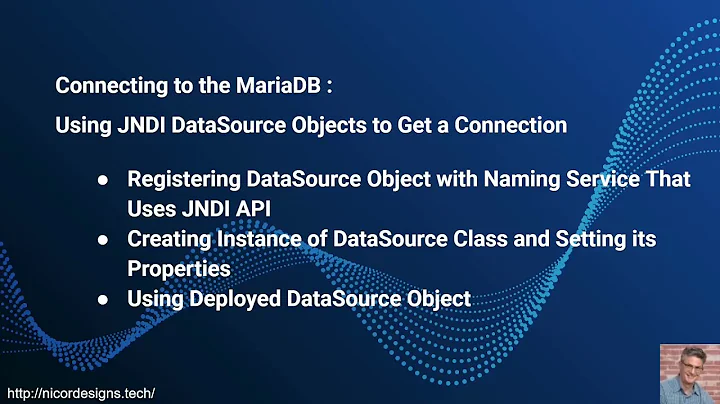How to use JNDI DataSource provided by Tomcat in Spring?
Solution 1
If using Spring's XML schema based configuration, setup in the Spring context like this:
<beans xmlns="http://www.springframework.org/schema/beans"
xmlns:xsi="http://www.w3.org/2001/XMLSchema-instance"
xmlns:jee="http://www.springframework.org/schema/jee" xsi:schemaLocation="
http://www.springframework.org/schema/beans http://www.springframework.org/schema/beans/spring-beans.xsd
http://www.springframework.org/schema/jee http://www.springframework.org/schema/jee/spring-jee.xsd">
...
<jee:jndi-lookup id="dbDataSource"
jndi-name="jdbc/DatabaseName"
expected-type="javax.sql.DataSource" />
Alternatively, setup using simple bean configuration like this:
<bean id="DatabaseName" class="org.springframework.jndi.JndiObjectFactoryBean">
<property name="jndiName" value="java:comp/env/jdbc/DatabaseName"/>
</bean>
You can declare the JNDI resource in tomcat's server.xml using something like this:
<GlobalNamingResources>
<Resource name="jdbc/DatabaseName"
auth="Container"
type="javax.sql.DataSource"
username="dbUser"
password="dbPassword"
url="jdbc:postgresql://localhost/dbname"
driverClassName="org.postgresql.Driver"
initialSize="20"
maxWaitMillis="15000"
maxTotal="75"
maxIdle="20"
maxAge="7200000"
testOnBorrow="true"
validationQuery="select 1"
/>
</GlobalNamingResources>
And reference the JNDI resource from Tomcat's web context.xml like this:
<ResourceLink name="jdbc/DatabaseName"
global="jdbc/DatabaseName"
type="javax.sql.DataSource"/>
Reference documentation:
- Tomcat 8 JNDI Datasource HOW-TO
- Tomcat 8 Context Resource Links Reference
- Spring 4 JEE JNDI Lookup XML Schema Reference
- Spring 4 JndiObjectFactoryBean Javadoc
Edit: This answer has been updated for Tomcat 8 and Spring 4. There have been a few property name changes for Tomcat's default datasource resource pool setup.
Solution 2
With Spring's JavaConfig mechanism, you can do it like so:
@Configuration
public class MainConfig {
...
@Bean
DataSource dataSource() {
DataSource dataSource = null;
JndiTemplate jndi = new JndiTemplate();
try {
dataSource = jndi.lookup("java:comp/env/jdbc/yourname", DataSource.class);
} catch (NamingException e) {
logger.error("NamingException for java:comp/env/jdbc/yourname", e);
}
return dataSource;
}
}
Solution 3
Assuming you have a "sampleDS" datasource definition inside your tomcat configuration, you can add following lines to your applicationContext.xml to access the datasource using JNDI.
<jee:jndi-lookup expected-type="javax.sql.DataSource" id="springBeanIdForSampleDS" jndi-name="sampleDS"/>
You have to define the namespace and schema location for jee prefix using:
xmlns:jee="http://www.springframework.org/schema/jee"
xsi:schemaLocation="http://www.springframework.org/schema/jee http://www.springframework.org/schema/jee/spring-jee-3.0.xsd"
Solution 4
Documentation: C.2.3.1 <jee:jndi-lookup/> (simple)
Example:
<jee:jndi-lookup id="dataSource" jndi-name="jdbc/MyDataSource"/>
You just need to find out what JNDI name your appserver has bound the datasource to. This is entirely server-specific, consult the docs on your server to find out how.
Remember to declare the jee namespace at the top of your beans file, as described in C.2.3 The jee schema.
Solution 5
Another feature:
instead of of server.xml, you can add "Resource" tag in
your_application/META-INF/Context.xml
(according to tomcat docs)
like this:
<Context>
<Resource name="jdbc/DatabaseName" auth="Container" type="javax.sql.DataSource"
username="dbUsername" password="dbPasswd"
url="jdbc:postgresql://localhost/dbname"
driverClassName="org.postgresql.Driver"
initialSize="5" maxWait="5000"
maxActive="120" maxIdle="5"
validationQuery="select 1"
poolPreparedStatements="true"/>
</Context>
Related videos on Youtube
Comments
-
Suzan Cioc over 4 years
It is said that in the Spring javadoc article about
DriverManagerDataSourceclass, that this class is very simple and that it is recommendedto use a JNDI DataSource provided by the container. Such a
DataSourcecan be exposed as aDataSourcebean in a Spring ApplicationContext viaJndiObjectFactoryBeanThe question is: how do I accomplish this?
For example, if I wish to have
DataSourcebean to access my custom MySQL database, what would I require then? What should I write in the context configuration, etc? -
 Étienne Miret over 10 years@skaffman Yes, but you provide a link to Spring reference documentation.
Étienne Miret over 10 years@skaffman Yes, but you provide a link to Spring reference documentation. -
Pavel Niedoba almost 9 yearswhat file exactly do you mean by "Tomcat's web context.xml" ?
-
kaliatech almost 9 years@PavelNiedoba Tomcat uses a "context" for tomcat specific web app configuration. The context file and/or context configuration can be placed in various locations, so I can't give you a definitive answer. A common location is "/META-INF/context.xml". See "Defining a context" section here: tomcat.apache.org/tomcat-8.0-doc/config/…
-
Phate over 8 yearsMmm...doesn't seem working for my oracle db, any differences with postgresql?
-
kaliatech over 8 years@Phate There are no fundamental differences with Oracle vs PostgreSQL at the JDBC/JNDI/Tomcat level. However, Oracle is very different from PostgreSQL when it comes to Oracle client/server setup details. Outside scope of original question/answer. Suggest posting a new question with details of what you have tried, specific versions, and any error messages. Example: stackoverflow.com/questions/10388137/…
-
Sajib Acharya about 8 years@kaliatech, hi, I was following a book, Pro Spring 3, and it said that while using the jee namespace we could write:
<jee:jndi-lookup jndi-name="java:comp/env/jdbc/databaseName">. I would like to know which approach is better as you are also using anexpected-typeattribute. Thanks. -
kaliatech about 8 years@SajibAcharya Using jee namespace or not was mostly a personal preference. Most people thought using the spring XML namespaces were more concise. The expected-type attribute is usually optional, and mostly for safety. If the lookup is not assignable to the given expected-type, a NamingException is thrown. Note that in most newer projects, this style configuration is no longer used. Most newer projects will use JavaConfig per Abdull's answer.
-
ViniciusPires over 7 yearsHow does this work with Spring Boot's embedded Tomcat? Where I put these config files?
-
kaliatech over 7 years@ViniciusPires If you are using Spring Boot then you would normally use Spring Boot's built-in support for configuring datasources or JavaConfig style configuration per Abdull's answer. For more information on spring boot's built-in support: docs.spring.io/spring-boot/docs/current/reference/html/…
-
Arend v. Reinersdorff over 7 yearsOr use the more specialized JndiDataSourceLookup
-
user3892286 about 7 yearsby this article, it explain how easy to create a db confguration based on database jndi(db/test) configuration. once you are done with configuration then all the db repositories are loaded using this jndi. I did find useful. If @Pierre has issue with this then let me know. It's complete solution to write db configuration.
-
 Sergio A. over 4 yearsby this article, it explain how easy to create a db confguration based on database jndi(db/test) configuration. once you are done with configuration then all the db repositories are loaded using this jndi. I did find useful. If @Pierre has issue with this then let me know. It's complete solution to write db configuration.
Sergio A. over 4 yearsby this article, it explain how easy to create a db confguration based on database jndi(db/test) configuration. once you are done with configuration then all the db repositories are loaded using this jndi. I did find useful. If @Pierre has issue with this then let me know. It's complete solution to write db configuration.




